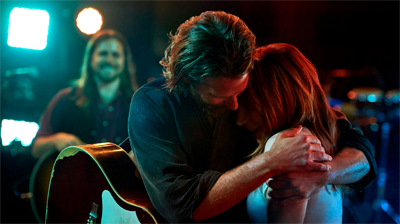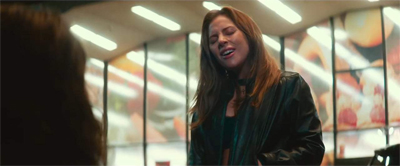At one point in A Star is Born, Bobby Maine outlines his brother’s approach to music for the benefit of Ally.
According to Bobby, Jackson believes that all music can be broken down to “twelve notes between an octave.” By Jackson Maine’s logic, Bobby explains all musical expression is “those same twelve notes, played over and over again. All any artist can offer the world is how they see those twelve notes.” It is a strange moment, one that comes very close to self-awareness from writer and director Bradley Cooper, suggesting something very close to a mission statement for his directorial debut.

Ain’t playin’.
A Star is Born is the fourth major American motion picture with that name and that premise. There are countless other stories built around the same basic concept, which has itself been translated into various settings and contexts across the globe. The story of A Star is Born is familiar. An older man discovers a talented young woman and elevates her to stardom, while his own grip on celebrity slips away between his fingers. It is an archetypal Hollywood story, and perhaps a defining American fairytale. All Cooper can do is tell that familiar story in his own way.
There are certainly moments when A Star is Born seems to take this idea to heart. In terms of basic trappings and mechanics, A Star is Born gestures towards modernity, understanding that it needs to update its core premise in the way that each of its three forerunners did. There are any number of details within A Star is Born that position the film within the modern cultural context. This is a twenty-first century take on a familiar story, and it looks distinct enough from the earlier three iterations.

Has a nice sing to it.
However, there’s a recurring anxiety within A Star is Born, a sense of trepidation. In terms of style and sensibility, Cooper’s adaptation hews closest to the country-and-western infused seventies remake with Barbara Streisand and Kris Kristofferson, which is a canny choice; it is probably the least seen and the least iconic iteration of the story, making it ripe for reinvention. However, there is also a strong sense that A Star is Born is reluctant to cross the four decades that have passed since that particular iteration of the familiar story.
The result is a film that feels at odds with itself. A Star is Born is inherently a metafictional text, suggesting a rebirth of Lady Gaga from a pop star to a credible leading actor in a prestige piece. Gaga acquits herself well in the role, but A Star is Born feels uncertain and untrusting of her. Repeatedly, A Star is Born seems to refuse to let Gaga be Gaga, instead adhering to a very fixed and very nostalgic seventies ideal of “authenticity.” This is a film that ends with the assertion that a modern pop star can only find herself when using her voice to deliver an ageing rocker’s words.

Doesn’t quite hit all the right notes.
A Star is Born works best as a showcase for Bradley Cooper, as one might expect. The actor is consciously rebranding himself as a potent creative force, the familiar actor-auteur. It is no surprise that A Star is Born is a product of Warner Brothers. Warner Brothers are among the oldest and most iconic studios in Hollywood, and so are anchored in that same sense of history evoked by this formative fairy tale. The Warner Brothers water tower is a distinctive landmark, even to those who have never actually visited Los Angeles.
More to the point, Cooper’s relationship with Warner Brothers is very much in keeping with how the studio develops its talent. Cooper is far from the only actor to reinvent himself as a prestigious director with the help and support of Warner Brothers. Ben Affleck managed to radically rework his public image, transforming from a late nineties hunk into a twenty-first century prestige film-maker. Coopers is clearly aiming for a similar transformation, seeking to transcend the foundation of his stardom as the actor made famous by The Hangover films.

Going head-to-head.
However, Cooper clearly has an older pedigree in mind. Clint Eastwood is another actor-turned-director who has a longstanding relationship with Warner Brothers anchored in his ability to produce reliable prestige pieces on a regular basis. It is no small compliment to Cooper that A Star is Born evokes those early Eastwood-directed films from the seventies. There’s an impressive grounded quality to the direction in A Star is Born, a cleanness to its composition and framing, a low-key naturalistic approach to its performances that evokes Eastwood.
There is also that quiet and understated confidence that Eastwood demonstrated even in his early films, a desire to showcase his directorial talent without ever seeming overly intrusive. Cooper consciously keeps the camera moving in A Star is Born, favouring handheld tracking shots through locations rather than static cuts. There are now assertive “look at this!” oners like the famous assault at the advertising company in Three Billboards Outside Ebbing Missouri, but instead a lot of quietly confident longish takes that allow scenes to play without frantic editting.

Box office or bussed.
Cooper is very clearly influenced by old-school seventies film-making in terms of his visual storytelling. There’s a strong emphasis on naturalism in how he shoots particular sequences. The camera lingers in a way that feels more trusting and relaxed than the frantic crosscutting associated with more contemporary cinematic storytelling. Cooper does an especially great shot with the movie’s big showcase sequences, the music numbers often delivered in front of gigantic crowds.
Cooper manages to keep these sequences intimate while also suggesting scale, by shooting intense close-ups on his actors’ faces and then almost obscuring them with blinding coloured lighting or by going for an awe-inspiring low-angle shot that presents the central characters as titans towering over this world that they have constructed. A Star is Born demonstrates incredible potential for Cooper as a film-maker. It is very clear that A Star is Born applies as much to Cooper’s reinvention as an auteur as it does to Lady Gaga’s reinvention as an actor.

Making a concerted effort.
A Star is Born should hinge on novelty. That idea is baked into the premise. A Star is Born is essentially a discovery myth, the story so fundamental to the American character. An aging entertainment figure discovers a diamond in the rough, a younger and more talented performer who offers something new and exciting. It is essentially a gold rush story, where the younger artist is the gold. Youth is key here. Read in the romantic of lights, A Star is Born is essentially a story about Hollywood (and America) rejuvenating itself. A star is born from the supernova remnants.
There’s certainly an aspect of that in the casting of Lady Gaga. After all, Beyonce was originally suggested to play the role. There is a sense of the passing of the guard baked into A Star is Born, which is essentially the story of an ageing rock god who happens to discover this intensely talented young woman who just happens to be played by this hugely famous modern pop star. The basic arc of A Star is Born writes itself, even before Jackson Maine gets up on stage to singing, “Maybe it’s time to let the old ways die.”

“You’ve never seen Music and Lyrics? You should get on that.”
Except, of course, there’s never a sense that A Star is Born actually believes that in any meaningful way. As one might expect given Bradley Cooper’s directorial influences, A Star is Born is anchored in a very seventies sense of authenticity. Nostalgia is woven into the fabric of A Star is Born, even before Andrew Dice Clay shows up as a man of wasted potential who claims he could have been a better singer than Frank Sinatra and Dave Chapelle stops by to play somebody who exists largely outside of the fame game in which Jackson Maine is entangled.
A Star is Born believes that authenticity looks like Jackson Maine, a country-infused rock star with a bushy beard and a fine guitar. “You stole my voice,” his brother Bobby pointedly asserts during one early argument. Jackson retorts, “You weren’t using it to say anything interesting.” The implication is that Jackson is a true artist, even in his most self-destructive phases and even consumed by alcohol and drug addiction. Jackson might have grown old disgracefully, but he is still a titan. He is the living embodiment of the baby boomer generation’s unshakable faith in rock ‘n’ roll.

Going Gaga.
There are nods to modernity to be found within the film. Ally is introduced screaming “f%$k men!” in a bathroom in barely controlled rage. Jackson discovers Ally playing at a gay bar, in a transvestite cabaret as “one of the gay girls.” Ally knows that she has made it when she plays Saturday Night Live. There’s discussion of viral videos shared on line, even if characters wonder what “impressions” and “algorithms” actually are. Alcoholism is recognised as “a disease.” Most interestingly, A Star is Born understands the awkward gender politics that underscore a film like this.
A Star is Born makes a point to subvert certain gender roles and expectations. In the movie’s big fist-fight, it is Ally who throws the punch in order to defend Jackson. Repeatedly over the course of the film, Ally is presented as a protector of Jackson. This is obviously an attempt to downplay the obvious power imbalance in their relationship, but it occasionally feels a little awkward, as if portraying celebrity and wealth as some sort of grand tragedy. When somebody snaps a picture of him, Jackson brushes it off, “It’s okay.” Ally stands up for him, clarifying, “It’s not okay.”

Holding it together.
However, for all of this, the film seems weirdly anxious about the presence of Lady Gaga in its key role, as a representation of the future of celebrity and art in the United States. Gaga is certainly qualified to shoulder that weight in the context of the film. Like Judy Garland or Barbara Streisand before her, Gaga is a certified rock star with a firmly established public persona. More than that, Gaga inherently understands celebrity and the act of being an icon. One of her defining albums is literally called The Fame Monster.
Nevertheless, A Star is Born spends a lot of time playing with the idea of Gaga-as-Ally and seeming to strongly suggest that Ally can only really find herself as an artist if she rejects the trappings associated with Gaga’s stage persona. There is a sense within A Star is Born that Ally needs to conform to a very nostalgic idea of “authenticity”, one that consciously exists in contrast to the stage persona that Gaga has so carefully cultivated to this point. There is a recurring sense that Jackson Maine wouldn’t know what to make of Gaga, and his reaction would be correct.

Join the club.
At one point, a confused Jackson picks over the lyrics to Ally’s latest pop infused hit. “I listened to it over and over,” he tells her. “What does it mean?” As Ally prepares to launch her career, Jackson prophetically advises her, “If you don’t dig deep inside yourself, you won’t have legs.” Ally is stunned at the image that the label has cultivated for her, involving elaborate back-up dancers and stylish photographers. “That doesn’t look like me,” Ally observes with a hint of irony during one photoshoot.
There is a somewhat awkward fixation on the idea that Gaga is ugly an unattractive, which feels like it plays into the absurdity of Hollywood standards of beauty – Ally is repeatedly told by various characters that she is “ugly” or that she would “have had a record deal by now if it wasn’t for [her] nose.” To be fair to A Star is Born, the film never dwells too heavily on the point. A charitable reading would suggest that this is just Ally’s insecurity being weaponised against her, but the film leaves the issue open.

A checkered history.
A Star is Born suggests that artistic authenticity has a particular style, that it looks more like a country rock star than a millennial pop icon. Ally writes a lot of her own music, but at one point she discovers a song that Jackson had written for her to sing. “I thought you might find it,” Jackson confesses to her. “When you got back to you.” There is an implication that Ally is not herself at this moment, despite the fact that she is wearing a blouse that literally reads “oh oh oh oh oh oh” in bold yellow text so as to evoke Lady Gaga’s distinctive backing track to Poker Face.
There is something a little uncomfortable in all of this, in the idea that the persona of Lady Gaga is inherently inauthentic in a way that Jackson Maine is not. This feels like a crass dismissal of an entire brand of distinctive popular music. While it might not be to everybody’s taste, Lady Gaga’s style of pop undoubtedly speaks to some people very authentically. There’s a reason that this review and the film’s publicity machine calls her “Lady Gaga” and not “Stefani Germanott.” Gaga means a lot to her so-called “little monsters.”

Park it there.
As such, there is something unsettling in the film’s implication that Ally can only truly be herself when she sings a song that was written by a washed up middle-aged rock star. In hindsight, it makes sense that A Star is Born never materialised with Beyonce in the younger female role, as that would have just rendered these uncomfortable nostalgic politics even clumsier. A Star is Born plays to a very seventies idea of what art is. The closest thing that the film has to a villain is a broad two-dimensional Simon Cowell imitator, who even speaks with a British accent.
To be fair to Cooper, there are some interesting ideas at play within A Star is Born. There are some engaging recurring visual motifs, such as the director’s recurring fixation on faces. Ally’s face is repeatedly blown up and enhanced to suggest her fame; on monitors, on billboards, at awards ceremonies. This renders her larger than life At the same time, Ally and Jackson connect with one another by obscuring their faces, covering them in cream and other distractions, the film suggesting that the pair might shed their celebrity around one another.

The Maine Men.
A Star is Born is very well made. The performances are generally impressive. Gaga and Cooper work well enough with one another, enjoying an easy chemistry that helps to carry some of the film’s more broad strokes approach to characterisation. However, the film belongs to Sam Elliot as Bobby Maine, the older brother who has a strained relationship with his more successful sibling. A talented individual untouched by artistic vision and unelevated by the same divine spark as Ally or Jackson, Bobby is perhaps the film’s most interesting and compelling character.
A Star is Born is a very old-fashioned piece of prestige cinema, despite some nods to modernity. It is old-fashioned in its storytelling and in its perspective.
Filed under: Non-Review Reviews | Tagged: a star is born, bradley cooper, film, non-review review, review, sam elliot |




















Great review! I hope to catch it this weekend. I’m glad to read something that’s being a bit critical of different aspects of the film.
I hope you enjoy!